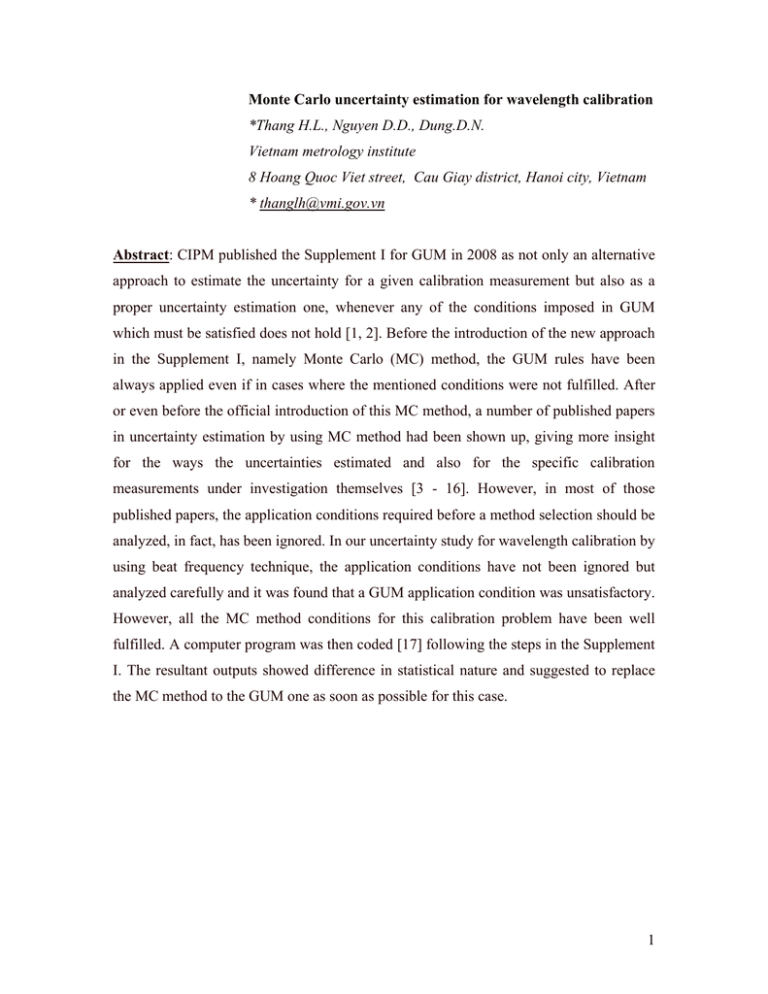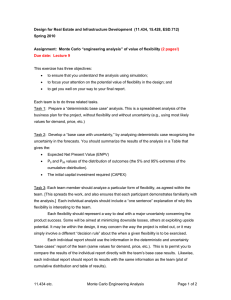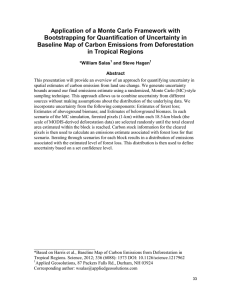Tính độ không đảm bảo đo bằng phương pháp mô
advertisement

Monte Carlo uncertainty estimation for wavelength calibration *Thang H.L., Nguyen D.D., Dung.D.N. Vietnam metrology institute 8 Hoang Quoc Viet street, Cau Giay district, Hanoi city, Vietnam * thanglh@vmi.gov.vn Abstract: CIPM published the Supplement I for GUM in 2008 as not only an alternative approach to estimate the uncertainty for a given calibration measurement but also as a proper uncertainty estimation one, whenever any of the conditions imposed in GUM which must be satisfied does not hold [1, 2]. Before the introduction of the new approach in the Supplement I, namely Monte Carlo (MC) method, the GUM rules have been always applied even if in cases where the mentioned conditions were not fulfilled. After or even before the official introduction of this MC method, a number of published papers in uncertainty estimation by using MC method had been shown up, giving more insight for the ways the uncertainties estimated and also for the specific calibration measurements under investigation themselves [3 - 16]. However, in most of those published papers, the application conditions required before a method selection should be analyzed, in fact, has been ignored. In our uncertainty study for wavelength calibration by using beat frequency technique, the application conditions have not been ignored but analyzed carefully and it was found that a GUM application condition was unsatisfactory. However, all the MC method conditions for this calibration problem have been well fulfilled. A computer program was then coded [17] following the steps in the Supplement I. The resultant outputs showed difference in statistical nature and suggested to replace the MC method to the GUM one as soon as possible for this case. 1 I Introduction: CIPM published the Supplement I for GUM in 2008 as not only an alternative approach to estimate the uncertainty for a given calibration measurement but also as a proper uncetainty estimation approach, whenever any of the conditions required must be satisfied in order to be able to follow the steps in GUM, does not hold [1, 2]. Before the introduction of the new approach in the Supplement I, namely Monte Carlo (MC) method, the GUM rules have been always applied even if in cases the mentioned conditions were not fulfilled (perhaps, because there was no other choice for people to calculate this parameter then). After or even before the official introduction of this MC method, a number of published papers in uncertainty estimation by using MC method have been shown up, giving more insight for the way the uncertainties estimated and also for the specific calibration measurements under investigation themselves [3 - 16]. In particular, in the case of wavelength calibration using beat frequency technique, it is apparent that some of the required conditions is not fulfilled for GUM to be used as seen in the following examination. However, all the conditions required in the MC method for this calibration problem have been well fulfilled. Therefore the impossibility of using the GUM method for uncertainty estimation becomes clear, and the MC application is now becoming the only right option. To numerically illustrate for the argument mentioned above, we carried out an uncertainty estimation by using the MC method for a wavelength calibration measurement by using beat frequency technique for an HP laser source which has been long time served as a wavelength standard in the laboratory of length measurement at Vietnam Metrology Institute (VMI). The resulted uncertainties estimated from those two approaches have been seen quite different in statistical natures as will be seen in the following sections. II. Calibration measurement setup and modeling The wavelength calibration setup is of a typical beat frequency technique. The standard laser and the laser under test (LUT) are fixed on an anti vibration optical table with optical mirrors, splitter, electric optical modulation etc. as shown in the diagram in figure 1 [18]. The beat signal is led to the frequency counter. The spectrum analyzer is 2 used for rough tuning the beat. The beat signal will be then transferred to a computer and the data is processed here with the assistance of the Laser call 3.0 software [19]. Frequency counter RF-spectrum analyzer PC with Laser call 3.0 Figure1. Beat frequency technique setup used for wavelength calibration. The standard laser is an iodine frequency stabilized He-Ne one, model Winter 100. This laser source generates a 633 nm laser beam, with the relative uncertainty 2.5x10-11. The 633 nm LUT is a laser source made by HP [19, 20]. In the wavelength calibration measurement, the often used mathematical model has the form: Y = F(X) = X(1) + X(2) + X(3) (1) Where X are the influencing factors constitute of X(1) – standard frequency, X(2) – beat frequency and X(3) – division of the frequency counter. The measurand Y is the frequency of the LUT. 3 It is seen from the model equation (1) that this model equation is linear in its nature, and its first order partial derivatives with respect to the input independent variables are in existence. It is also straightforward to check the continuity of the equation (1) within the vicinity of the estimated input variables. The distribution of Y is also increasing and the density function is single-peaked etc. We can summarize the conditions which need to be satisfied when one would like to apply either approach in table 1. The satisfied condition will be marked as (X) otherwise there will be left blank. Table1. Application conditions need to be satisfied for a method to be applied in this calibration measurement. GUM’s conditions the Welch - Satterthwaite GUM Supplement I - Monte Carlo MC satisfaction method’s conditions satisfaction (X) F(X) is continuous with (X) formula is adequate for respect to the elements X(i) calculating the effective of X in the neighbourhood of degrees of freedom the best estimates x(i) of the associated X(i) with u(y) [GUM:1995 G.4.1], when one or more of the u(xi) has an associated degrees of freedom that is finite; the Xi are independent (X) the distribution function for Y (X) when the degrees of is continuous and strictly freedom associated with the increasing u(xi) are finite; the PDF for Y can the PDF for Y is adequately be approximated 1) continuous over the by a Gaussian distribution interval for which this PDF is or a scaled and shifted t- strictly positive, distribution. 2) unimodal (single-peaked), (X) (X) 4 and 3) strictly increasing (or zero) (X) to the left of the mode and strictly decreasing (or zero) to the right of the mode; 4) E(Y ) and V (Y ) exist; (X) 5) a sufficiently large value of (X) M is used. After an examination of the required conditions as shown in table 1, it is apparent that the GUM method should not be used due to the unsatisfactory last condition. The reason is the dominant influencing factor of beat frequency has the probability density function of rectangular, leading to the non-student distribution of the output measurand values. As it was mentioned above, the GUM rules have been still used in the community, however, by the understanding of the authors, due to there has been no other approach around then. It seems very serious if then the estimated uncertainty of the wavelength would be applied to a next measurement with the assumption of its Gaussian/Student distribution as often misused unavoidable among the community. Fortunately, all the conditions required in the MC use for this problem have been seen satisfactory. So in this case, in order to properly estimate the uncertainty for the wavelength problem using the model (1), MC method becomes the only right option. III. Result and discussion The values of those above stated influencing factors and their corresponding standard uncertainties and some other parameters of the laser sources stated above are given in table 2 as follows: Table2. Information of influencing factors: symbol, value, type of distribution, upper and lower limit, divisor, standard uncertainty and sensitivity. Dimension in GHz. № Influencing factors Symbol Value Distribution Lower limit Upper limit Divisor ui ci 01 Standard frequency X(1) 473612.3536 Gaussian - - 1 1.2E-05 1 02 Beat frequency X(2) 0.16305987 Rectangular -0.0012623 0.00126226 1.73205 0.00073 1 03 Division of counter X(3) 0 Rectangular -5E-12 5E-12 1.73205 2.9E-12 1 5 We have coded a computer program [17] following the steps given in the Supplement I. Take the inputs in table 2 to run the code we obtained the results represented in figure 3. The distributions of the three influencing factors used as the inputs for the Mote Carlo method have the forms in figure 2. 40000 Standard frequency 12000 10000 35000 30000 8000 25000 20000 6000 15000 4000 10000 2000 5000 0 473612.3535 473612.3536 473612.3536 473612.3536 473612.3536 12000 Beat frequency 0 0.16179761 0.16242874 0.16305987 0.163691 0.16432213 Division of counter 10000 8000 6000 4000 2000 0 -5E-12 -2.5E-12 0 2.5E-12 5E-12 Figure 2. Monte Carlo method to estimate the uncertainty: histograms of the input influencing factors. Horizontal axis is frequency in GHz, vertical is the appearance counting. 14000 Result 12000 10000 8000 6000 4000 2000 0 473612.5152 473612.5159 473612.5166 473612.5173 473612.5181 Figure3. Monte Carlo method to estimate the uncertainty: the resultant output histogram. Horizontal axis is frequency in GHz, vertical is the appearance counting. From the resultant distribution for the measurand, the lower and upper limit of the range corresponding to the probability 95% has been obtained. The uncertainty has been calculated by the method suggested in GUM for the comparison purpose also (although GUM should not be applicable inhere). The estimates reached by the both ways have been tabulated in table 3. 6 Table3. Uncertainty (probability 95%) and the limits calculated via MC and GUM method. Values are in GHz. GUM uncertainty 0.001458 MC lower -0.001199 MC upper 0.001199 It is clearly seen that the resultant probability density function is an approximately rectangular one, not a student or normal. This result agrees with the one obtained from the uncertainty budget observation itself. Furthermore, there is a difference also in the final estimated uncertainty. IV. Conclusion Since the birth of GUM in 1993, a united way for uncertainty expression over the world metrology community has been established. However the application of this approach has not been scientifically proper in every case, but still people keep using it because there was no other option around. After the official introduction of the MC method in the Supplement I in 2008 from CIPM, the application conditions for the both GUM and MC methods have been considered more thoroughly. Consequently those conditions need to be examined before a decision on which method should be used will be made. In the wavelength calibration uncertainty estimation problem, we have shown that there was an unsatisfactory condition existed in GUM application, but all of the conditions in the MC approach are fulfilled. The MC resultant distribution has an unsimple form far off the Gaussian or Student one as commonly expected or conventioned in GUM previously. This difference suggests that all the conditions required in both methods must be analyzed carefully before a method selection is decided. In particular, the MC method needs to be adopted as soon as possible in the wavelength calibration in place of the GUM one, because the GUM one has been shown un-applicable, but the MC one. 7 V. Reference 1. BIPM: Evaluation of measurement data – Guide to the expression of uncertainty in measurement. JCGM 100:2008. 2. BIPM: Evaluation of measurement data – Supplement 1 to the "Guide to the expression of uncertainty in measurement" – Propagation of distributions using a Monte Carlo method. JCGM 101:2008. 3. The use of a Monte Carlo method for evaluating uncertainty and expanded uncertainty. Maurice G Cox et al 2006 Metrologia 43. 4. Evaluation of Monte Carlo Methods for Assessing Uncertainty. Ning Liu, Dean S. Oliver, U. of Oklahoma. Journal SPE Journal, Volume 8, Number 2, Date June 2003, Pages 188-195. 5. Reducing Uncertainty in Site Characterization Using Bayes Monte Carlo Methods. Michael D. Sohn, A.M.ASCE, Mitchell J. Small, M.ASCE, and Marina Pantazidou, A.M.ASCE. Journal of Environmental Engineering, Vol. 126, No. 10, October 2000, pp. 893-902, (doi 10.1061/(ASCE)0733-9372(2000)126:10(893)). 6. Nuclear instruments & methods in physics research. Section A, Accelerators, spectrometers, detectors and associated equipment, ISSN 0168-9002, Vol. 538, Nº. 1, 2005, pages. 631-639. Two-stage Monte Carlo approach to the expression of uncertainty with non-linear measurement equation and small sample size. S. V. Crowder. 7. Monte Carlo simulation of solar p-mode profiles revisited: Bias and uncertainty estimation from one, not many, fits. Y. Elsworth, W. J. Chaplin, T. Toutain. Astronomy and astrophysics: A European journal, ISSN 0004-6361, Vol. 433, Nº. 2, 2005, pages. 713-716. 8. Monte Carlo uncertainty calculations with small-sample estimates of complex quantities. B. D. Hall. Metrologia: International journal of scientific metrology, ISSN 0026-1394, Vol. 43, Nº 3, 2006, pages. 220-226. 9. Estimation of primary pH measurement uncertainty using Monte Carlo simulation. J. C. Damasceno, R. M. H. Borges. Metrologia: International journal of scientific metrology, ISSN 0026-1394, Vol. 43, Nº 3, 2006, pags. 306-310. 8 10. A markov chain monte carlo method for inverse stochastic modeling and uncertainty assessment. Jianlin Fu. Thesis directed by José Jaime Gómez Hernández. Universitat Politècnica de València (2008). 11. System uncertainty modeling using Monte Carlo simulation. L. Coughlan. Measurement and control, ISSN 0020-2940, Vol. 33, Nº 3, 2000, pages. 78-81. 12. Monte Carlo uncertainty analysis of germanium detector response to MeV. M. Mau¿ec, P.P. Maleka. Nuclear instruments & methods in physics research. Section A, Accelerators, spectrometers, detectors and associated equipment , ISSN 0168-9002, Vol. 538, Nº. 1, 2005, pages. 631-639. 13. A two-stage Monte Carlo approach to the expression of uncertainty with nonlinear measurement equation and small sample size. S. V. Crowder. Metrologia: International journal of scientific metrology, ISSN 0026-1394, Vol. 43, Nº 1, 2006, pages. 34-41. 14. Monte Carlo uncertainty calculations with small-sample estimates of complex quantities. B. D. Hall. Metrologia: International journal of scientific metrology, ISSN 0026-1394, Vol. 43, Nº 3, 2006, pages. 220-226. 15. Estimation of primary pH measurement uncertainty using Monte Carlo simulation. 16. J. C. Damasceno, R. M. H. Borges. Metrologia: International journal of scientific metrology, ISSN 0026-1394, Vol. 43, Nº 3, 2006, pages. 306-310. 17. Đỗ Đức Nguyên: User manual of Monte Carlo method software program, Vietnam Metrology Institute. Metrology Info, 2010 (in Vietnamese). 18. Bùi Quốc Thụ: Wavelength calibration procedure by using beat frequency technique. Vietnam Metrology Institute, 2002. 19. User manual for I2 frequency stabilized He-Ne laser source, Winter 100. University of Colorado – USA. 20. Bùi Quốc Thụ and et. ala. Bilateral comparison between Vietnam Metrology Institute and Korea Research Institute For Science and Standards for wavelength standards, laser source Model Winter 100, 2004. 9





